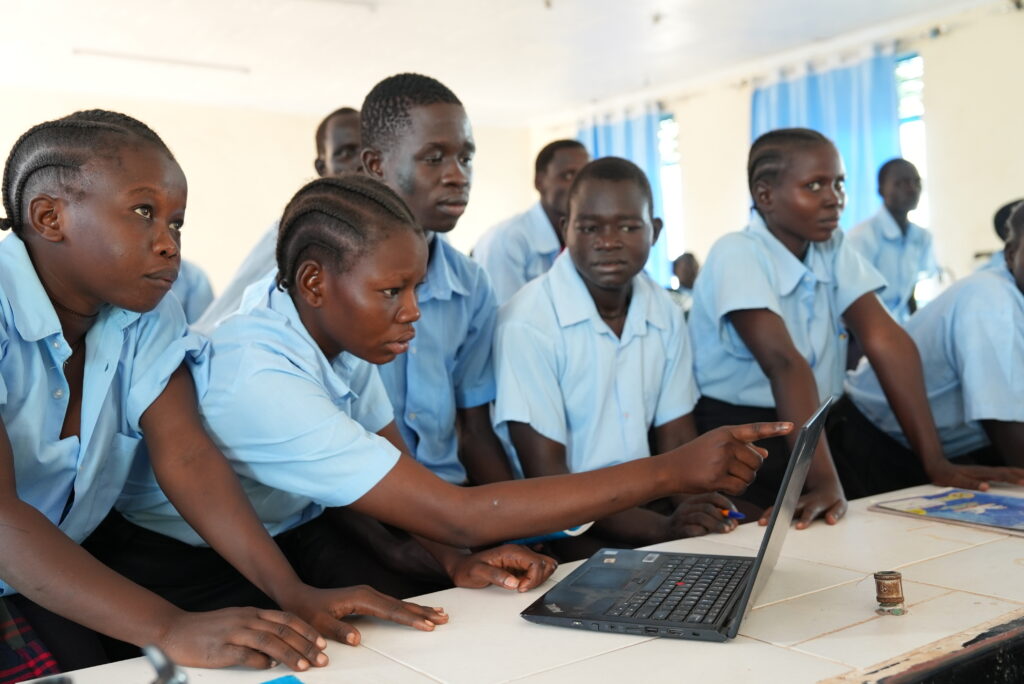17-year-old Darlene Vakoko is a Congolese refugee, she lives in a small brick walled house with corrugated iron sheets. Along with her parents and her younger brother, she fled the ravages of the armed conflict in the Democratic Republic of Congo seeking the relative peace and stability of the Kakuma refugee camp in northern Kenya. The camp is home to over 250,000 refugees, most from South Sudan and Somalia. It’s among the seventh largest refugee camps in the world.
Darlene doesn’t talk much about her life back in the DRC, rather focusing on her life at school, her face lights up when talking about her future, “When I am finished with my studies I want to be a software engineer,” she says. Darlene goes to Brightstar Integrated Secondary School. All of the 1,385 pupils at the school are refugees.
Darlene has good reason to want to be a software engineer because at school she has learnt how to code – and with the help of her classmate Sala Thomas they have built a website for the school. “The website is about managing time in school, and it enhances learning activities and administration activities in school” says Darlene. Sala who is also 17 is South Sudanese, was born and raised in Kakuma camp. He is proud of the work they have done on the website, when he finishes school he wants to pursue a career as a web developer and photography. “My aim is to teach and help people and to look for solutions to the problems that we have in our community,” says Sala.
Brightstar Secondary is a digitally connected school which was made possible through Giga, a joint UNICEF-ITU initiative to connect schools. Digital connectivity infrastructure such as routers, internet network towers, solar panels is dotted throughout the school. ICT teacher Antony Njambi is happy about the impact of the internet at the school, “The Giga connectivity program has been very instrumental in this school as far as ICT integration in teaching and learning is concerned. Both teachers and students can go to the internet to do their research. They don’t necessarily need to rely on just the normal, traditional books” he said.
Giga’s Commitment to Refugee Education
Since 2020, UNICEF Kenya, with the support of Giga, a joint initiative between UNICEF and the International Telecommunication Union (ITU), has led efforts to expand internet connectivity in public primary schools across Kenya. In collaboration with the Ministry of Education and the Ministry of ICT, UNICEF Kenya identified 1,160 schools for connection, of which 659 were connected by May 2025. This has benefited over 425,459 students and teachers across the country.
In alignment with its mission to connect every school to the internet, Giga has made a strategic commitment to include refugee-hosting schools in national connectivity plans.
At the ITU’s Partner2Connect Annual Meeting and UNHCR’s Global Refugee Forum in December 2023, ITU and UNICEF announced the “Mapping Refugee Schools” pledge in support of the Connectivity for Refugees multi-stakeholder commitment. This pledge extends Giga’s global effort to ensure that displaced children and youth have equal access to high-quality, connected education.
With over 36.5 million school-aged children among the world’s 122 million forcibly displaced and stateless people (Source: UNHCR), Giga’s work seeks to close a growing equity gap. In n Kenya, Giga helped connect 49 refugee-hosting schools in Kakuma and Dadaab refugee camps, alongside UNICEF Kenya.
In Kakuma, connectivity has been enabled through partnerships with Kenya’s Information and Communication Technology Authority (ICTA), leveraging the National Optic Fiber Backbone Infrastructure (NOFBI). This public-sector-led model allows connected schools to benefit from sustainable, cost-free service in cases where operational budgets are limited.
Connecting schools in Kenya has been a collaborative effort, made possible by the generous support of several key partners. The Information and Communication Technology Authority (ICTA), Ministry of ICT and the Digital Economy(MICDE), and the Ministry of Education have been instrumental in guiding and leading national efforts to connect schools. These initiatives have been supported by a range of public and private sector partners, including Safaricom, Frontier Optical Networks, Airtel, and Nokia. Additional support has come from the European Union, Dubai Cares, the Estonian Centre for International Development (ESTDEV), and the Government of the Netherlands through the PROSPECTS partnership.

